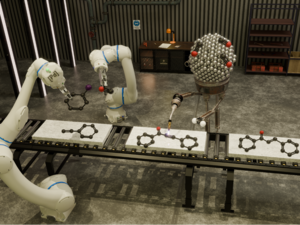Manisha Durai, a PhD student in the Multifunctional Catalytic Systems team led by Dr. Alexis Bordet in the Molecular Catalysis Department of Prof. Leitner at the Max Planck Institute for Chemical Energy Conversion has developed a novel one-pot synthesis of E-chalcones using a hybrid catalyst, Ru@SiO₂-[Pd-NHC]. This system combines ruthenium nanoparticles and palladium NHC complexes on a silica support, enabling multi-step transformations within a single reaction vessel. The resulting E-chalcones products serve as important building blocks in the synthesis of fine chemicals (e.g. UV filters, dyes, etc.) and pharmaceuticals (e.g. anti-cancer and anti-inflammatory drugs).
The catalytic process seamlessly integrates two key transformations. The Pd-NHC complex catalyzes the carbonylative Sonogashira coupling of aryl iodides and phenylacetylenes with CO, forming an intermediate, which is subsequently hydrogenated selectively by Ru nanoparticles to yield the desired E-chalcone. The heterogeneous nature of the catalyst allows for easy recovery and reuse, while the one-pot reaction minimizes waste and toxic solvent use, aligning with green chemistry principles. This tandem approach enhances efficiency, eliminates intermediate purification and isolation, and ensures high selectivity and yield, making it attractive for practical applications.
In particular, the Ru@SiO₂-[Pd-NHC] catalyst demonstrates outstanding activity, selectivity, and versatility toward the synthesis of a broad scope of valuable E-chalcones. Its excellent robustness and recyclability make it of great interest for practical application at the laboratory and industrial scales. Our approach to catalyst design is simple and versatile, providing new opportunities for the development of more efficient and sustainable synthetic routes.
This open access paper was recently published by the journal Chemical Science.
- Original Publication: M. Durai, Y. Wu, J. Johny, W. Hetaba, T. Wiegand, W. Leitner and A. Bordet, Chem. Sci., 2025, 16, 5776-5785. https://doi.org/10.1039/D4SC07773C
- Featured on the inside front cover of the journal: https://pubs.rsc.org/en/content/articlelanding/2025/sc/d5sc90078f
- Patent filed on 19.12.2024: One-Pot Carbonylative Coupling Reaction and Hydrogenation Reaction Using a Multifunctional Catalyst.

